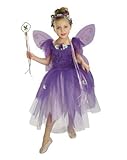 This spritely costume consists of a purple chiffon dress with a velour top. White and purple flowers adorn the bottom of the dress and neckline. The costume also includes gossamer wings, a wand and flowered headpiece. A great Halloween costume!
This spritely costume consists of a purple chiffon dress with a velour top. White and purple flowers adorn the bottom of the dress and neckline. The costume also includes gossamer wings, a wand and flowered headpiece. A great Halloween costume!I thought, with the holiday season nearly upon us, that it might be entertaining to look into the history of the greeting card. I discovered an eclectic blend of history, numerical facts, and amusing anecdotes. So let's take a moment during this hectic holiday season to relax and learn a little something about the Christmas Card.
- The custom of sending greeting cards dates back to Ancient China. In order to celebrate the New Year, the ancient Chinese delighted in sending messages of good will. Early Egyptians utilized papyrus scrolls to send their greetings. New Year's tidings were being produced in Germany as early as 1400.
- The origin of the Christmas Card is in England. They are a product of boys practicing their writing skills. The boys would practice by making cards for their parents.
- Sir Henry Cole commissioned the first commercial Christmas cards in London in 1843. Sir Henry was extremely busy that year, and as a result was unable to compose the typical individual greetings. The simple message, "A Merry Christmas and a Happy New Year to You" was found on the inside. John Callcott Horsley produced an illustration for the card that depicted a happy family hugging and toasting with their glasses raised. The drawing was disparaged by critics for promoting intoxication.
- In the US, Louis Prang produced the first commercial Christmas cards. He was a German immigrant, who in 1856 started a little lithographic business close to Boston. He is considered the creator of the greeting card industry in the United States. More than five million cards were being produced by 1881. His cards gained increasing popularity through the 1890's. Prong stopped producing greeting cards when cheaper imports came onto the market.
- The first official White House card was issued in the year of 1953 by President Eisenhower. 2000 cards were sent out by the White house in the year 1961. The amount grew to 1.4 million by the year 2005.
- Today's Christmas cards can be bought as singles or in large boxes. Individual cards are usually sent to somebody special, while the boxed ones are very helpful for your more general Christmas Mailing List. The majority of holiday cards are sold in box form.
- In 2006, 2 billion people in the US sent cards.
- That means, 85% of people in the US mailed cards in 2006.
- Approximately 33% of the holiday cards purchased each year contain a religious message.
- About a third of all annual greeting card sales are related to holiday season.
- Christmas cards are the most popular cards of a season. Christmas cards account for 60% of all card sales. A distant second is Valentine's Day at 25%.
- The U.S. is home to approximately 3,000 greeting card publishers.
- "Merry Christmas" is the preferred text for 54% of holiday card purchasers. "Season's Greetings" is liked by 12 %, and "Happy Holidays" is preferred by 21%.
- When it comes to decide which boxed cards to buy, 56% of us take the decision based on the variety of cards available, and for 63%, price is the most influential factor. Shopping with online distributors can easily satisfy both conditions. Unlike a typical store, they can display more cards without space limitations.
I hope you enjoyed this little ramble into the story of the Christmas Card. As is evident, this annual holiday rite, is of major interest to everyone, everywhere.
John Oberhauser manages The Image Shop which carries several types of holiday paper for making the family greeting letter look fabulous. They also carry printable designer invitation paper and letterhead stationery for quickly creating a professional custom look for your personal or business stationery needs at less cost.
No comments:
Post a Comment